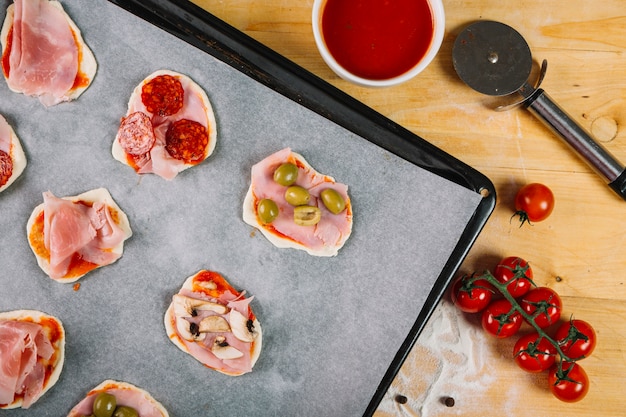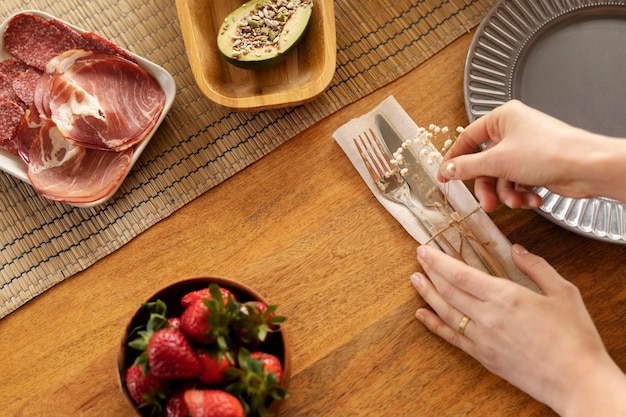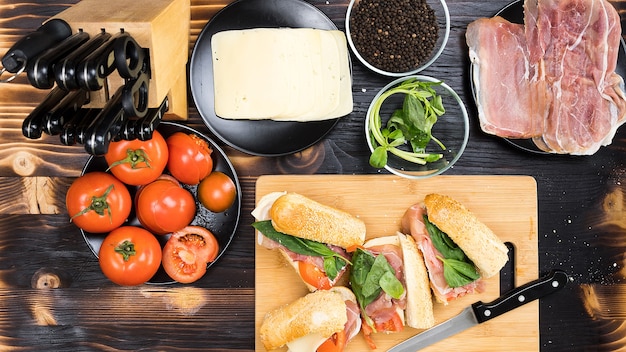As a seasoned home cook with a deep love for all things delicious, I've always found myself drawn to the art of cooking ham. There's just something so satisfying about transforming a simple piece of meat into a culinary masterpiece, and ham is no exception. From festive holiday gatherings to casual weeknight dinners, a perfectly cooked ham is guaranteed to be a crowd-pleaser. But let's be honest, figuring out the right cooking time for a ham can be a bit of a head-scratcher, especially if you're dealing with different sizes and cuts. That's where my handy-dandy per-pound guide comes in – a culmination of years of experience and countless ham-cooking adventures. So, grab your apron, your favourite recipe, and let's dive into the world of succulent, perfectly cooked ham.
Part 1: Understanding the Basics

Before we get lost in the details of cooking times, it's important to have a firm grasp of the different types of ham available and the factors that influence cooking time. This knowledge will help you choose the right cooking method and ensure a delicious outcome.
1.1 Types of Ham: A Journey Through Curing and Flavors
The world of ham is surprisingly diverse, with each type offering a unique flavor profile and requiring different cooking approaches.
- fresh ham: This is uncooked ham, often referred to as "green ham." It's the most basic form, requiring a longer cooking time to ensure it's thoroughly cooked and safe to eat. Fresh ham tends to have a milder flavor compared to cured varieties.
- cured ham: This ham has undergone a curing process, a fascinating journey involving salting and sometimes smoking, that preserves the meat and imparts a distinct flavor. Cured ham is generally ready to eat, but additional cooking can enhance its flavor and texture.
- dry-cured ham: Imagine a ham lovingly cured through the magic of dry salt and air. This process results in a ham with a strong, salty flavor and a firm texture. Examples of dry-cured ham include the iconic prosciutto and serrano ham, both prized for their intense flavor and delicate texture.
- wet-cured ham: This ham takes a different path, soaking in a brine or solution that imparts a milder flavor and a juicy texture. This category includes ham steaks, ham roasts, and those popular spiral-sliced hams that are perfect for carving.
1.2 The Importance of Weight: Sizing Up Your Ham
The weight of your ham is a crucial factor that dictates the cooking time. A larger ham, like a hefty holiday roast, will naturally take longer to cook than a smaller ham, say, a ham steak for a weeknight dinner. Don't worry, my trusty per-pound guide will take the guesswork out of it!
1.3 Cooking Methods: Choosing the Right Approach
Ham can be cooked using a variety of methods, each with its unique advantages and quirks. Let's explore some popular options:
- Oven-baking: This is the traditional method, known for delivering even cooking and a delicious, crispy outer crust. It's a great choice for a holiday ham, as it allows for a beautiful presentation with a golden brown exterior.
- slow cooker: This method is all about hands-off cooking, letting the slow cooker work its magic to create a tender, juicy ham with minimal effort. It's ideal for those busy days when you want a stress-free approach.
- Boiling: This is a simple and straightforward method for cooking a large ham, ensuring even cooking. However, boiling can sometimes result in a less flavorful end product than other methods, and it won't give you that crispy crust.
- Grilling: This method is perfect for summer gatherings, adding a smoky, chargrilled flavor to your ham. It's a fun way to cook ham, but it's important to use a grill with enough space to accommodate a large ham and to monitor the heat carefully to prevent burning.
The chosen cooking method will have a significant impact on the overall cooking time, so make sure to adjust the time based on the method you select.
Part 2: Ham Cooking Time Guide: A Timetable for Deliciousness

Now, let's get down to the nitty-gritty and delve into the specific cooking times for different types of ham based on their weight. This guide will provide you with a starting point for your ham-cooking adventures.
2.1 Oven-Baking: The Classic Approach
Oven-baking is a beloved method for cooking ham, offering a delicious combination of crispy skin and tender, juicy meat. Here's a guide to cooking times for oven-baked ham, based on weight:
| Ham Weight (lbs) | Cooking Time (hours) |
|---|---|
| 4-6 | 1.5-2 |
| 7-9 | 2-2.5 |
| 10-12 | 2.5-3 |
| 13-15 | 3-3.5 |
| 16-18 | 3.5-4 |
It's important to remember that these are general guidelines, and the actual cooking time might vary depending on the type of ham, the temperature of your oven, and your desired level of doneness. A thermometer will be your best friend here.
2.2 Slow Cooker: Hands-Off Cooking for Tender Ham
slow cooking is a fantastic option for those who appreciate a relaxed approach to cooking. It allows you to create a melt-in-your-mouth ham with minimal effort. Here's a guide to cooking times for slow cooker ham:
| Ham Weight (lbs) | Cooking Time (hours) |
|---|---|
| 4-6 | 6-8 |
| 7-9 | 8-10 |
| 10-12 | 10-12 |
Remember to choose a slow cooker with a large enough capacity to comfortably accommodate your ham. Also, keep in mind that the cooking time may need to be adjusted based on the size and type of ham you're using.
2.3 Boiling: A Simple and Reliable Method
Boiling is a simple and reliable method for cooking a large ham, especially when you need a straightforward approach. It ensures even cooking but might not result in the same crispy skin as other methods. Here's a guide to cooking times for boiled ham:
| Ham Weight (lbs) | Cooking Time (hours) |
|---|---|
| 4-6 | 1.5-2 |
| 7-9 | 2-2.5 |
| 10-12 | 2.5-3 |
When boiling ham, make sure the water completely covers the ham. Bring the water to a boil, then reduce the heat to a simmer and cook for the recommended time. Remember, the cooking time may vary based on the ham's weight and type.
Part 3: Checking for Doneness: Ensuring Perfect Results

It's crucial to ensure your ham is cooked to the right internal temperature for food safety and to achieve the perfect texture and flavor. Here's how to check for doneness:
3.1 Using a meat thermometer: The Ultimate Tool
The most reliable method for determining doneness is using a meat thermometer. Insert the thermometer into the thickest part of the ham, ensuring it doesn't touch any bone. The ham is cooked through when the internal temperature reaches 145°F (63°C). This is a safe temperature for all types of ham, including cured ham.
3.2 Visual Cues: Observing the Signs
While using a thermometer is highly recommended, you can also rely on some visual cues to indicate doneness. The ham's juices should run clear when pierced, and the meat should feel firm to the touch. These cues can provide a general sense of doneness, but they shouldn't replace the use of a thermometer for accuracy.
3.3 Doneness Chart: A Quick Reference
Here's a handy chart summarizing the internal temperatures for different levels of doneness, providing a quick reference for your ham-cooking adventures:
| Level of Doneness | Internal Temperature (°F) |
|---|---|
| Rare | 125-130 |
| Medium-rare | 130-135 |
| Medium | 135-140 |
| Medium-well | 140-145 |
| Well-done | 145 |
Remember, the level of doneness you prefer will depend on your personal taste. For a more tender ham, aim for a lower internal temperature. For a firmer texture, cook to a higher internal temperature. However, always ensure the ham reaches a safe internal temperature of 145°F (63°C) for food safety.
Part 4: Glazing for Extra Flavor: Adding a Touch of Magic
Glazing your ham during the final stages of cooking is a simple way to elevate its flavor and create a beautiful, glossy finish. Think of it as adding a touch of magic to your culinary masterpiece.
- honey-mustard glaze: A classic combination of sweet honey and tangy mustard, perfect for a savory glaze that complements the ham's natural flavor. It's a crowd-pleasing choice that adds a touch of sweetness and tanginess.
- brown sugar glaze: Simple yet effective, brown sugar glaze adds a rich caramel flavor and a beautiful golden brown color. It's a classic choice for a traditional ham glaze that everyone loves.
- pineapple glaze: Sweet and tangy, pineapple glaze adds a tropical twist to your ham, making it perfect for a festive gathering. It's a fun and unexpected flavor combination that will delight your guests.
- Maple Syrup Glaze: A touch of maple syrup adds a delicious, sweet and smoky flavor to your ham, making it ideal for those who appreciate a slightly more complex flavor profile. It's a wonderful choice for a holiday ham or a special occasion.
To glaze your ham, simply brush your chosen glaze over the ham during the last 30 minutes of cooking, allowing it to caramelize and create a beautiful, glossy finish. The heat from the oven will help the glaze melt and set, creating a delicious coating that will enhance the ham's flavor.
Part 5: Resting and Serving: Letting the Ham Relax and Shine
Once your ham is cooked through, it's essential to let it rest for 10-15 minutes before slicing. This allows the juices to redistribute throughout the meat, resulting in a more succulent and flavorful ham. It's like giving the ham a moment to relax and recover after its cooking adventure.
Serve your ham with a variety of sides, such as mashed potatoes, green beans, or a refreshing salad. The ham's savory flavor pairs beautifully with a variety of side dishes, making it a versatile centerpiece for any meal.
Part 6: Leftovers and Storage: Making the Most of Your Ham
ham leftovers are a delicious treat, perfect for sandwiches, salads, or simply enjoyed on their own. They're a great way to extend the enjoyment of your culinary creation and add flavor to other meals.
Store any leftovers in an airtight container in the refrigerator for up to 4 days. This helps to prevent spoilage and preserve the ham's freshness. You can also freeze cooked ham for up to 2 months, but it may lose some of its texture when thawed.
Part 7: Tips and Tricks: The Insider Secrets of Ham Cooking
Over the years, I've gathered a few tips and tricks that have helped me perfect my ham cooking. These are the secrets I've learned along the way, designed to make your ham-cooking journey smoother and more delicious.
- Score the Ham: Scoring the ham's fat layer before cooking helps the fat render more quickly and creates a crispy, flavorful crust. It's a simple technique that adds a significant flavor boost and a beautiful visual appeal.
- Use a roasting pan: A roasting pan with a rack is ideal for cooking ham in the oven. It allows for even heat distribution and prevents the ham from sitting in its juices. It's a practical tool that ensures your ham cooks evenly and maintains its juiciness.
- Add Flavor: Don't be afraid to experiment with different flavor combinations! Add aromatics like onions, garlic, and herbs to your roasting pan for extra flavor. This is a great way to personalize your ham and create unique flavor profiles. Remember, the possibilities are endless!
- Don't Overcook: Overcooked ham can become dry and tough. Use a thermometer to ensure your ham is cooked to the right internal temperature. It's better to err on the side of slightly undercooked than overcooked, as you can always cook it a little longer if needed.
Part 8: Personal Experiences: A culinary journey
Over the years, I've had many memorable experiences cooking ham, from holiday gatherings to family dinners. Each experience has been a learning opportunity, shaping my approach to ham cooking and creating fond memories. Here are a few of my favorites:
I still remember the time I tried a new recipe for a honey-mustard glazed ham. The result was a culinary triumph, with the sweet and savory flavors perfectly complementing the tender ham. The whole family raved about it, and it became a family favorite, a testament to the power of a well-executed glaze.
Another time, I took on the challenge of slow-cooking a large spiral-sliced ham for a potluck. The ham was so tender and juicy, it literally fell apart at the touch. It was a real crowd-pleaser, and I felt a surge of pride as everyone complimented my culinary skills. It reminded me of the satisfaction of creating a dish that brings joy to others.
Part 9: FAQs: Your Ham Cooking Questions Answered
Here are some frequently asked questions about cooking ham, providing answers to your most common queries and helping you navigate the world of ham cooking with confidence.
9.1 Can I cook a ham from frozen?
It's not recommended to cook a ham from frozen. The ham will take longer to cook, and it may not cook evenly. It's best to thaw the ham in the refrigerator for 24 hours before cooking, ensuring it thaws thoroughly and cooks evenly. This will provide you with the best results and ensure food safety.
9.2 What can I do with leftover ham?
Leftover ham is incredibly versatile! You can use it in sandwiches, salads, soups, or simply enjoy it on its own. Get creative and experiment with different recipes. Here are a few ideas to inspire you:
- ham and cheese sandwiches: A classic combination that's always a crowd-pleaser.
- Ham and potato salad: A refreshing and flavorful salad that's perfect for picnics or potlucks.
- Ham and bean soup: A hearty and comforting soup that's perfect for cold weather.
- Ham Quiche: A savory quiche filled with ham, cheese, and vegetables.
9.3 How long can I store cooked ham in the refrigerator?
You can store cooked ham in the refrigerator for up to 4 days. Be sure to store it in an airtight container to prevent spoilage and maintain its freshness. This will help you enjoy your ham for a few days after cooking it.
9.4 Can I freeze cooked ham?
Yes, you can freeze cooked ham for up to 2 months. However, it may lose some of its texture when thawed. If you choose to freeze it, wrap it tightly in plastic wrap or aluminum foil and place it in a freezer-safe bag. Thaw the ham in the refrigerator before using it, ensuring it thaws thoroughly before cooking.
9.5 What are some good side dishes to serve with ham?
Ham pairs well with a variety of side dishes. Some popular choices include:
- Mashed Potatoes: A classic combination that's comforting and delicious.
- Green Beans: A simple and refreshing side dish that complements the ham's savory flavor.
- sweet potato Casserole: A sweet and savory side dish that adds a touch of indulgence.
- Cornbread: A Southern classic that pairs beautifully with ham.
- Macaroni and Cheese: A cheesy and comforting side dish that's always a crowd-pleaser.
- Refreshing Salad: A light and flavorful salad to balance out the richness of the ham. Try a combination of fresh greens, seasonal fruits, and a light vinaigrette.
Cooking a delicious ham is a rewarding experience that adds a touch of elegance and flavor to any meal. By following this per-pound guide, incorporating my personal tips and tricks, and exploring the world of ham with confidence, you're sure to create a culinary masterpiece that will leave your guests wanting more. So, put on your apron, gather your ingredients, and embark on your next ham-cooking adventure! Happy cooking!
Everyone is watching

How to Cook Frozen Lobster Tails Perfectly: A Step-by-Step Guide
RecipesLobster. Just the word conjures up images of lavish meals, special occasions, and a taste of luxury. But let's...

Pigs in a Blanket Cooking Time: How Long to Bake for Perfect Results
RecipesAh, pigs in a blanket. Just the name conjures up images of those delightful little parcels of crispy pastry en...

Pork Fillet Cooking Time: How Long to Cook It Perfectly
RecipesPork fillet, or tenderloin as it's sometimes called, is a real favourite in our house. It's so versatile, and...

The Ultimate Guide to Tender, Juicy Pulled Pork
RecipesRight, let's talk pulled pork. It's one of those dishes that just screams "comfort food," doesn't it? I mean...

The Ultimate Guide to Cooking Delicious Frankfurters
RecipesLet's face it, we all love a good frankfurter. It's a classic, simple, and always satisfying. But let's be rea...
